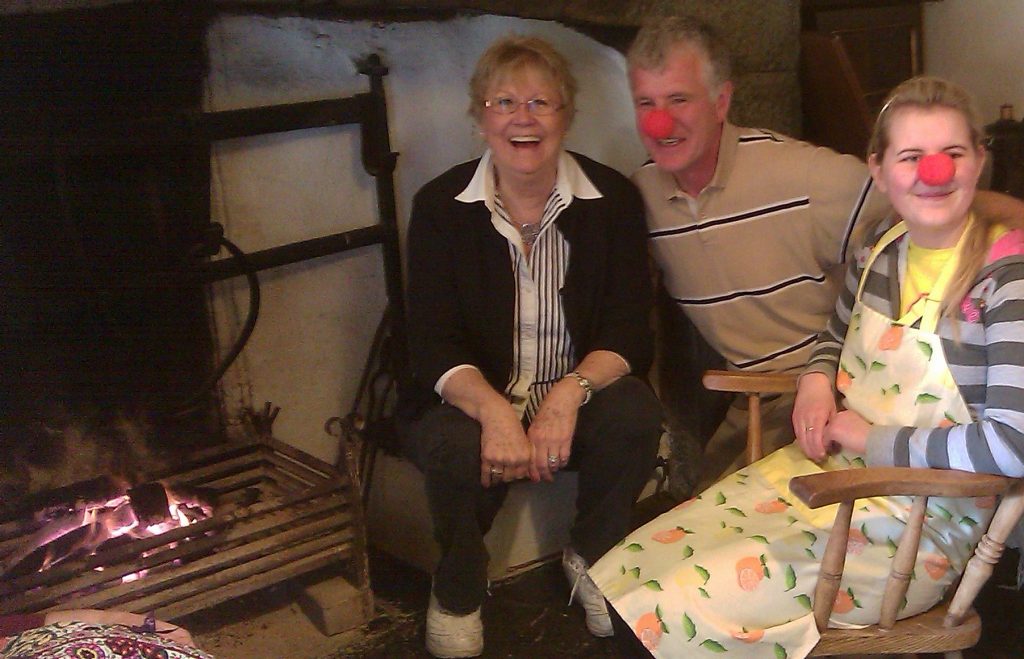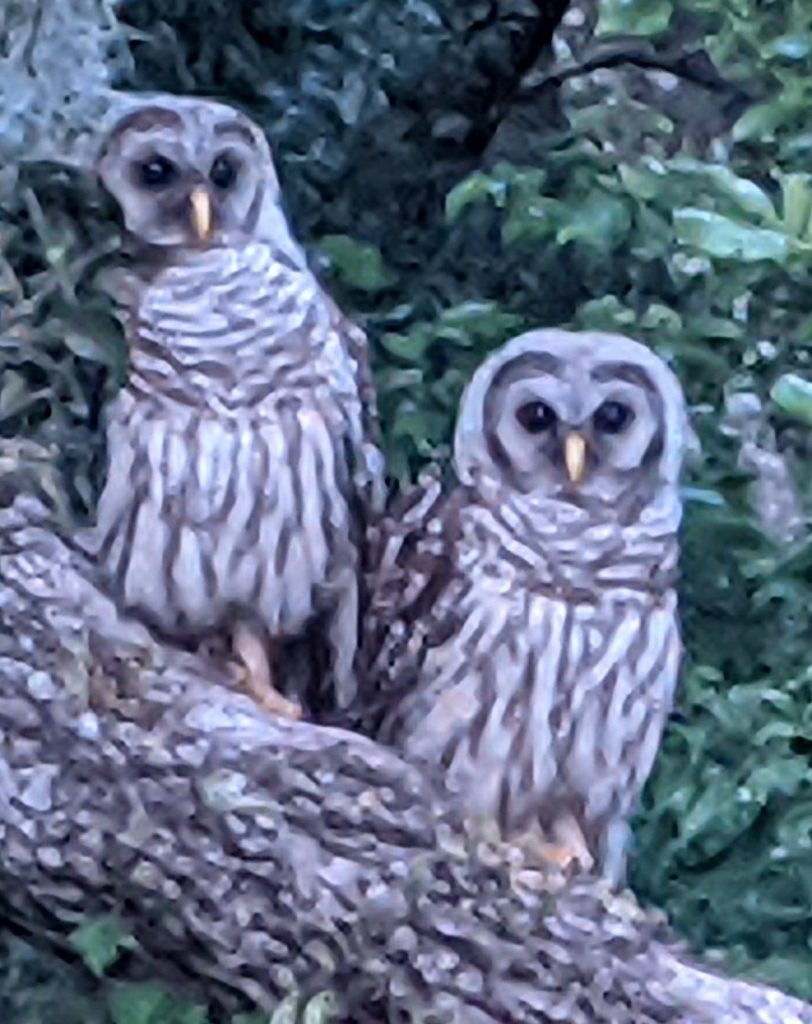Marjorie is frozen. The camera she holds in her right hand is aimed skyward, not at its intended target. The rest of us are moving into position to become the foreground of a fairly-typical tourist shot – a photo to include a backdrop of mountains, cactus, and the really nice, brand-new, red Yukon XL to which Hertz has upgraded us for a mere five dollars per day additional. The sun is bright and hot. Colorful flowers and blooming cactus offer evidence of a rare but recent desert rainfall. The air is clean and clear – a perfect day in the desert Southwest.
So, why is she not framing the picture and preparing to push the button? Her face is betraying a jumble of emotions. Fear? Pain? Experiencing a medical moment? Michael is the first realize why Marjorie’s figure has become stationary – trembling – uncertain. He rushes toward her hoping to free her from the unwelcome condition. He reaches behind her and with an appropriate expletive he snatches his hand away and retreats.
What a scene! Painful – frightening – uncertain – but soon to become one of those travel tales that will bring tears of laughter to family, friends and co-workers for years to come. In attempting to frame her shot of the family, the mountains, the flora, and of course the red Yukon, Marjorie has backed into a beautiful little cactus bush. It really is beautiful – bright green pods – tiny orange flowers – soft-looking, fuzzy whitish hairs. Later we learned that local folks refer to this unexpectedly aggressive vegetation as jumping cactus. They say that the plant actually detects when life-vibration is near and reaches toward it. Whether the spiny shrubbery detected Marjorie’s presence, or whether she just invaded its space by backing into it while looking through her camera, I cannot say.
But now the situation seems serious. While trying to remove one of the culprits from Marjorie’s Capri-length pants, Michael’s hand has become full of fine needle-like spines, and he is trying to pluck them out one-by-one. Marjorie has been able to turn a bit giving us a better view of her condition. The sight is amazing! Stuck to the back of her pants in a most embarrassing location is a cucumber-shaped piece of the plant with thousands of hair-like spines. About a third of the spines are now attached to the fabric and have penetrated through to skin level. At the same time two other similarly-shaped appendages are firmly connected like velcro to the flesh of her calf below the hem of her three-quarter length slacks.
My first thought is to try to find a pair of leather gloves, but who carries leather gloves on vacation. Digging through one of the suitcases in the back of the Yukon I find a pair of athletic shorts to wrap around my hands. Thinking it will be easy to pull the pieces from her leg, I wrap the shorts around one of the plant parts and pull, but it does not freely release. I tug a little harder and realize the pain I am causing her by pulling. Knowing she cannot move around with these chunks of vegetation adhered to her flesh the decision is made to pull as hard as necessary to remove them. (Later we learned that each of the tiny spines has a barbed end like that of a fish hook – easy to go in – very difficult to come out.) So, I pull. The chunk of plant comes free. Many of the spines come free with it leaving little dots of blood at each exit wound. Many of the spines stay in needing to be extracted individually. But as I pull off the first one and drop it to the ground, not only do I get a few of the needles in my own hands but the cluster rolls against the flesh of Tracey’s flip-flopped foot. I’m not sure if she is talking to the cactus or to me as she backs-off and begins extracting needles from her bare foot. A home video of this fiasco would surely have won first prize on AFV.
Next stop – Walgreen’s – where a very knowledgeable pharmacist provides a tar-based paste to aid in the removal of remaining prickles; a topical antiseptic; a pair of tweezers; and, most of all, the assurance that the experience, though very uncomfortable, poses no health threat.
“Cholla,” says the Tucson cousin that evening as he works hard to conceal his amusement. For the benefit of us East Coast country folks we learn that the word is pronounced, “choy-ah.” We will remember it! Everyone at the family reunion in Tucson has a cholla cactus story as well as a remedy for barbed-spine removal. Extraction techniques include: scraping the affected skin area with the edge of a plastic credit card; shaving the area; brushing on a thin coat of Elmer’s glue to dry and then peel it off; pressing duct tape over the area and ripping it off. There is no shortage of home-remedies for recovering from an encounter with jumping cactus!
In defense of a trip to Tucson, I will add – there were no mosquitoes! Seriously though, do not write-off a desert vacation for fear of a picking up a few cactus spines or stepping on a rattlesnake. There are some incredibly beautiful and unusual topography and plant-life to be experienced in America’s desert Southwest. From the city of Tucson a steep ride up the mountain through the narrow, winding roads of Gates Pass brings us to the Saguaro National Park. Saguaro (pronounced sah-wah’-ro) is the name given to what many would consider traditional western cactus trees. Some are huge. From the no-guard-rail road and from scenic overlooks, miles and miles of incredible desert can be seen dotted with saguaro cacti and other smaller varieties of desert plants. The park is filled with driving trails and hiking paths to give visitors a more complete experience.
At one point along the narrow road through Saguara National Park I pull the red Yukon off the blacktop and onto the sand. Both Marjorie and I want to get close-ups of some of the flowering barrel cacti. It is just incredible to believe that blossoms can be as beautiful as they are in this arid environment. There is plenty of space to walk between the plants but still we are very careful to not make contact with any of them. Thinking we are finished with the pictures, I start toward the car and there is a yelp of pain from behind me. I turn and there is a spiny ball similar to a sand-burr but about the size of a plum hanging from Marjorie’s foot. If I can offer one tidbit of advice for visitors to the desert – do not wear sandals or flip-flops.
The night before leaving Tucson, I walk to the back of the Yukon and as I raise the rear-hatch and back up a bit, I feel a tingling sensation on my shoulder. The sensation soon becomes a sharp pain and I realize that in the dark I have backed into a jumping cactus growing innocently on the fence behind the car. I know that God made these things with a wonderful purpose in mind, but so far the secret of that purpose has not been revealed to me.
May All of Your Travels Be Happy and Safe!





